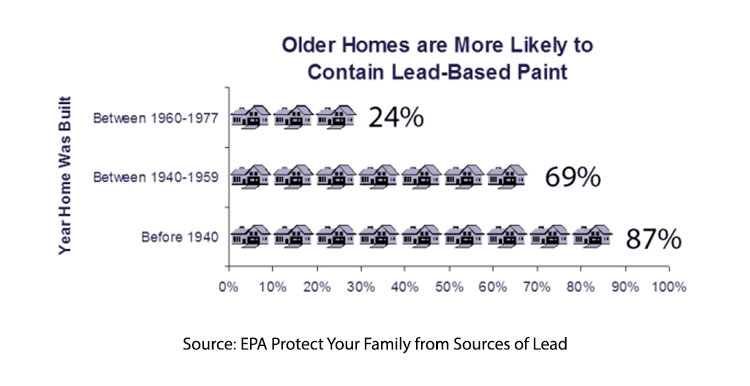Earlier, I wrote about the newly proposed regulation for lead in drinking water and other lead sources, including paint and air. I received several excellent comments, which enabled me to dig deeper into this issue. I hope this follow-up article provides helpful information.
What is the safe level of lead in the bloodstream?
Almost every publication about lead includes the following statement, “There is no safe threshold for lead exposure.” Although there is some truth to this statement, it would be more accurate to say:
The safe threshold for lead exposure is unknown, but it is very low, and to be safe, limit lead exposure to as low a level as possible.
I confidently state that there is a safe threshold for lead exposure because lead is a naturally occurring element in the earth’s crust. About 98% of the crust comprises eight elements: oxygen, silicon, aluminum, iron, calcium, sodium, potassium, and magnesium. The rest is made up of other elements, including lead. Lead is present in ore deposits worldwide, and because it is a naturally occurring element, there is no way to limit exposure; it will always be present in soil, air, and water. If any exposure to lead were unsafe, we could not safely breathe the air or drink the water – we would not exist.
However, lead is much more toxic than many other naturally occurring elements, and exposure should be limited. I am NOT minimizing the toxic effects of lead; we just do not know the exact amount that causes toxicity. Lead is primarily toxic to our nervous system, making children, whose nervous system is still developing more vulnerable to lead exposure than adults.
Since the removal of lead from gasoline, lead concentrations have decreased in all age groups in the US. Today's mean level for US adults is less than 1 microgram per deciliter [1] of blood, reduced from approximately 16 micrograms per deciliter in 1976 to 10 micrograms per deciliter in 1980.
What lead levels cause health problems in adults?
Blood levels of lead in adults reflect more recent exposures and may not reflect chronic exposure because lead is stored in our bones. According to the NY Department of Health
- Levels above 80 micrograms per deciliter are extremely dangerous, resulting in serious health damage.
- Levels between 40 and 80 micrograms per deciliter may result in asymptomatic but real health damage.
- Between 10 and 40 micrograms per deciliter, there can be intermittent or regular exposure, resulting in a build-up of lead with the potential for physiologic injury.
For adults, the most significant risk lies in the workplace. [2] The Occupational Safety and Health Administration (OSHA) has identified a blood lead level of 40 micrograms per deciliter or above to require medical monitoring. The World Health Organization (WHO) recommends that individuals with blood lead levels > 5 micrograms per deciliter eliminate their sources of lead exposure, and the Florida Department of Health considers 3.5 micrograms per deciliter to be of concern.
There are no clear-cut answers regarding the safe level of lead for adults. Studies have generally not shown health effects at <10 micrograms per deciliter or less; however, these low levels' impact on intellect and altered mood and behavior are difficult to quantify. The less exposure, the better.
What are the studies regarding lead in the paint in our homes? Is lead paint in our homes a rational or irrational fear?
The risk from lead-based paint is primarily to children who ingest the chips from peeling paint. If your home was built before 1978, it is more likely to contain lead-based paint. Lead was banned nationally in paint in 1978, but some States banned it earlier.
Currently, based on the Housing and Urban Development’s (HUD) American Healthy Homes Survey II, 34.6 million homes (29.4%) of all housing units contain lead-based paint.
- 18.2 million homes have significantly deteriorated lead-based paint
- 21.9 million homes have dust lead hazards.
However, the mere presence of lead-based paint in your home does not mean that you are at risk. The risk only occurs when the paint starts to chip or deteriorate. Even the EPA agrees that homes with lead-based paint, if properly maintained, pose little risk.
If you plan to sell your home, the EPA and HUD require that you disclose all lead-based paint in the housing and give the buyers a 10-day opportunity to test the housing for lead. Some States and cities have stricter notification and disclosure rules.
Renovation or repair projects can easily create hazardous levels of lead dust. The EPA Lead Renovation, Repair, and Painting Program requires that any projects disturbing lead-based paint in homes, child-care facilities, and preschools built before 1978 be done by lead-certified safe contractors. For homeowners, this applies if you rent all or part of your home, operate a child-care center in your home, or if you plan to flip the house.
For the DIYs amongst us, I strongly suggest hiring a professional. The Connecticut Department of Public Health offers some advice to the foolhardy who wish to proceed independently.
- Use personal protective equipment when working on painted surfaces,
- Use containment and barriers to prevent paint chips and dust from spreading from the work area,
- Do not dry scrape or sand painted surfaces,
- Wet all painted surfaces before scraping or sanding,
- Do not power wash.
[1] The deciliter is a metric unit of volume equal to one-tenth of a liter. The use of the deciliter as a unit in clinical measurements is primarily due to historical reasons and conventions that have been established over time.
[2] Workers can be exposed to lead in industries including lead smelting, battery manufacturing, scrap metal handling, ceramics and plastics manufacturing, and firing ranges.





